MOD001120: Analyzing Change Resistance at Oracle Corporation
VerifiedAdded on 2023/04/21
|23
|4694
|495
Report
AI Summary
This report provides a critical analysis of change resistance within Oracle Corporation, a leading computer technology and software solutions company. It identifies factors contributing to resistance, such as misperceptions, insecurity, and structural inertia, using Lewin's Force Field Analysis. The report proposes strategies to overcome these barriers, including education, communication, and increased employee participation, based on Kotter and Schlesinger's Six Change Approaches. Furthermore, it suggests using Lewin's Change Theory Model (unfreeze, change, freeze) for planning and implementing organizational changes effectively. The analysis is based on data collected from interviews with Oracle management and employees, combined with theoretical frameworks from academic literature. The report concludes with recommendations for facilitating a more open and adaptable organizational culture within Oracle.
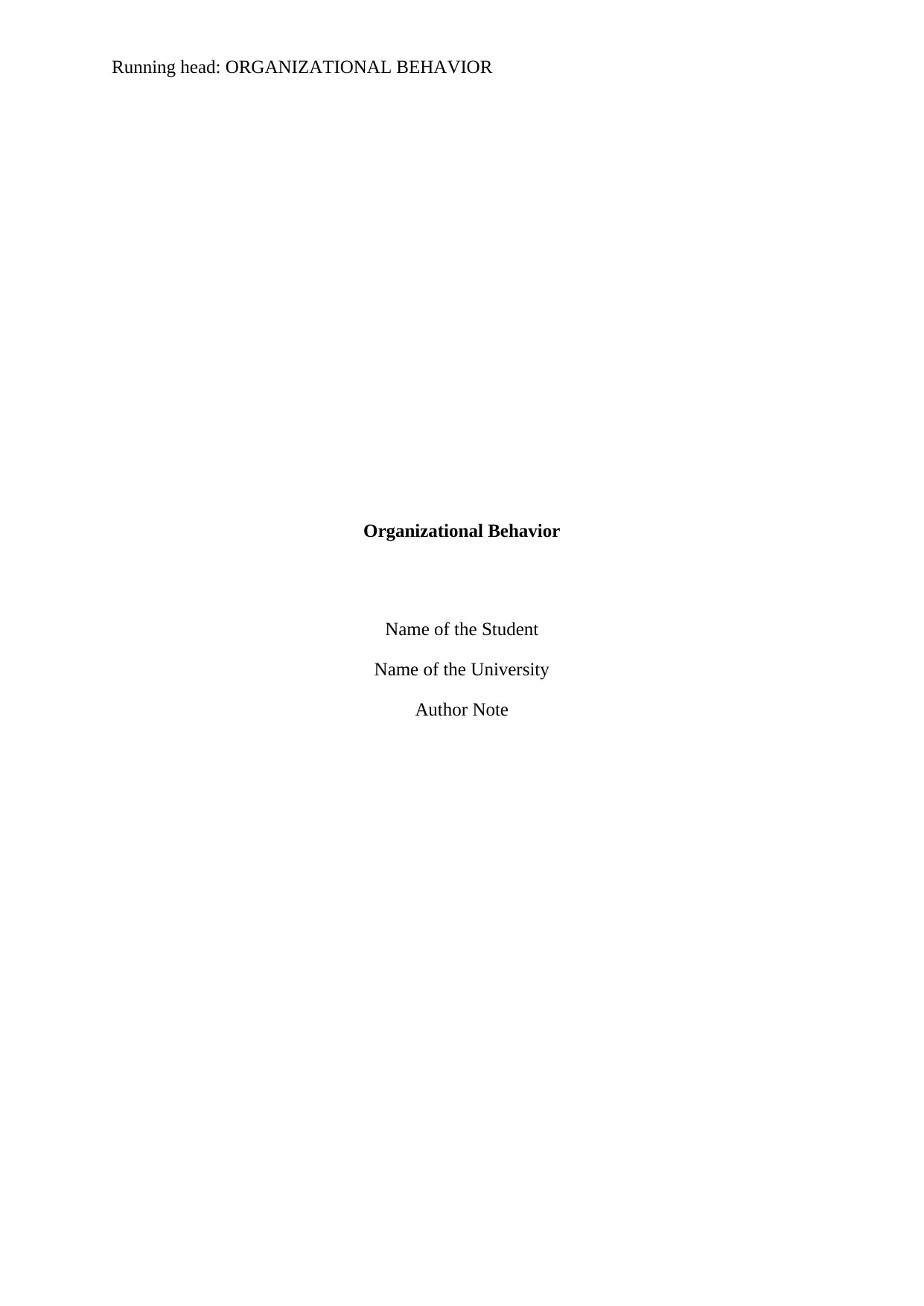
Running head: ORGANIZATIONAL BEHAVIOR
Organizational Behavior
Name of the Student
Name of the University
Author Note
Organizational Behavior
Name of the Student
Name of the University
Author Note
Paraphrase This Document
Need a fresh take? Get an instant paraphrase of this document with our AI Paraphraser
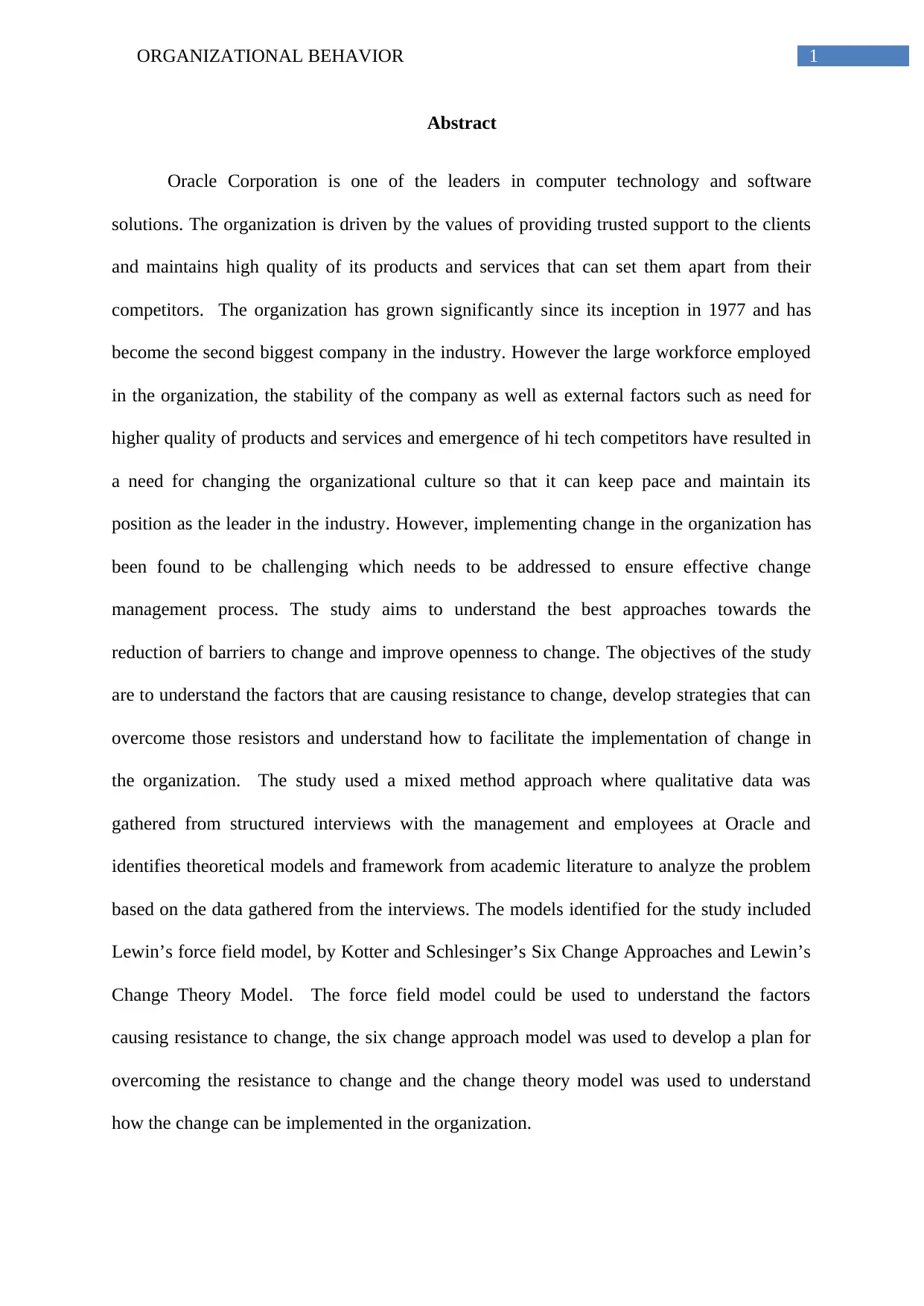
1ORGANIZATIONAL BEHAVIOR
Abstract
Oracle Corporation is one of the leaders in computer technology and software
solutions. The organization is driven by the values of providing trusted support to the clients
and maintains high quality of its products and services that can set them apart from their
competitors. The organization has grown significantly since its inception in 1977 and has
become the second biggest company in the industry. However the large workforce employed
in the organization, the stability of the company as well as external factors such as need for
higher quality of products and services and emergence of hi tech competitors have resulted in
a need for changing the organizational culture so that it can keep pace and maintain its
position as the leader in the industry. However, implementing change in the organization has
been found to be challenging which needs to be addressed to ensure effective change
management process. The study aims to understand the best approaches towards the
reduction of barriers to change and improve openness to change. The objectives of the study
are to understand the factors that are causing resistance to change, develop strategies that can
overcome those resistors and understand how to facilitate the implementation of change in
the organization. The study used a mixed method approach where qualitative data was
gathered from structured interviews with the management and employees at Oracle and
identifies theoretical models and framework from academic literature to analyze the problem
based on the data gathered from the interviews. The models identified for the study included
Lewin’s force field model, by Kotter and Schlesinger’s Six Change Approaches and Lewin’s
Change Theory Model. The force field model could be used to understand the factors
causing resistance to change, the six change approach model was used to develop a plan for
overcoming the resistance to change and the change theory model was used to understand
how the change can be implemented in the organization.
Abstract
Oracle Corporation is one of the leaders in computer technology and software
solutions. The organization is driven by the values of providing trusted support to the clients
and maintains high quality of its products and services that can set them apart from their
competitors. The organization has grown significantly since its inception in 1977 and has
become the second biggest company in the industry. However the large workforce employed
in the organization, the stability of the company as well as external factors such as need for
higher quality of products and services and emergence of hi tech competitors have resulted in
a need for changing the organizational culture so that it can keep pace and maintain its
position as the leader in the industry. However, implementing change in the organization has
been found to be challenging which needs to be addressed to ensure effective change
management process. The study aims to understand the best approaches towards the
reduction of barriers to change and improve openness to change. The objectives of the study
are to understand the factors that are causing resistance to change, develop strategies that can
overcome those resistors and understand how to facilitate the implementation of change in
the organization. The study used a mixed method approach where qualitative data was
gathered from structured interviews with the management and employees at Oracle and
identifies theoretical models and framework from academic literature to analyze the problem
based on the data gathered from the interviews. The models identified for the study included
Lewin’s force field model, by Kotter and Schlesinger’s Six Change Approaches and Lewin’s
Change Theory Model. The force field model could be used to understand the factors
causing resistance to change, the six change approach model was used to develop a plan for
overcoming the resistance to change and the change theory model was used to understand
how the change can be implemented in the organization.
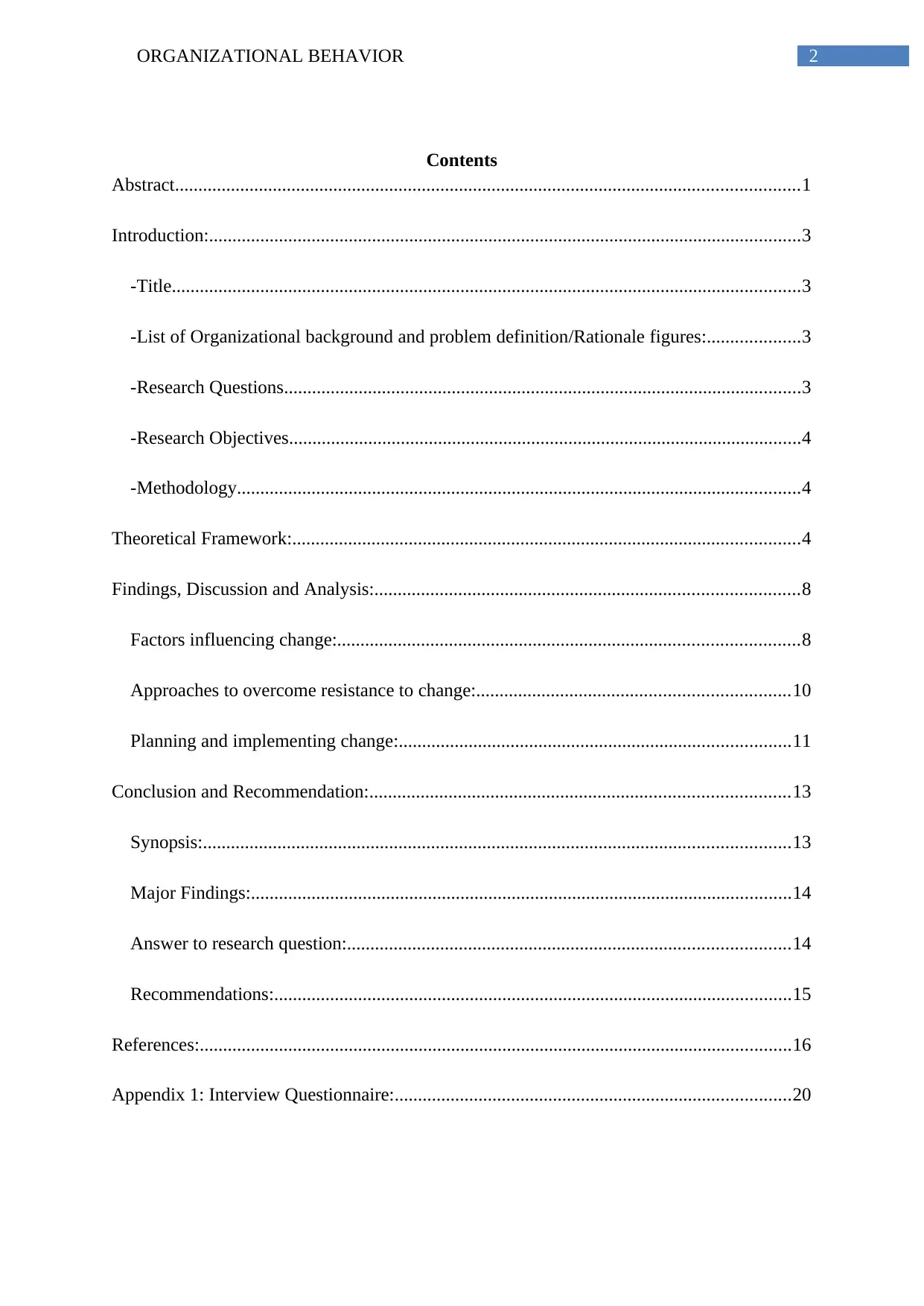
2ORGANIZATIONAL BEHAVIOR
Contents
Abstract......................................................................................................................................1
Introduction:...............................................................................................................................3
-Title.......................................................................................................................................3
-List of Organizational background and problem definition/Rationale figures:....................3
-Research Questions...............................................................................................................3
-Research Objectives..............................................................................................................4
-Methodology.........................................................................................................................4
Theoretical Framework:.............................................................................................................4
Findings, Discussion and Analysis:...........................................................................................8
Factors influencing change:...................................................................................................8
Approaches to overcome resistance to change:...................................................................10
Planning and implementing change:....................................................................................11
Conclusion and Recommendation:..........................................................................................13
Synopsis:..............................................................................................................................13
Major Findings:....................................................................................................................14
Answer to research question:...............................................................................................14
Recommendations:...............................................................................................................15
References:...............................................................................................................................16
Appendix 1: Interview Questionnaire:.....................................................................................20
Contents
Abstract......................................................................................................................................1
Introduction:...............................................................................................................................3
-Title.......................................................................................................................................3
-List of Organizational background and problem definition/Rationale figures:....................3
-Research Questions...............................................................................................................3
-Research Objectives..............................................................................................................4
-Methodology.........................................................................................................................4
Theoretical Framework:.............................................................................................................4
Findings, Discussion and Analysis:...........................................................................................8
Factors influencing change:...................................................................................................8
Approaches to overcome resistance to change:...................................................................10
Planning and implementing change:....................................................................................11
Conclusion and Recommendation:..........................................................................................13
Synopsis:..............................................................................................................................13
Major Findings:....................................................................................................................14
Answer to research question:...............................................................................................14
Recommendations:...............................................................................................................15
References:...............................................................................................................................16
Appendix 1: Interview Questionnaire:.....................................................................................20
⊘ This is a preview!⊘
Do you want full access?
Subscribe today to unlock all pages.

Trusted by 1+ million students worldwide
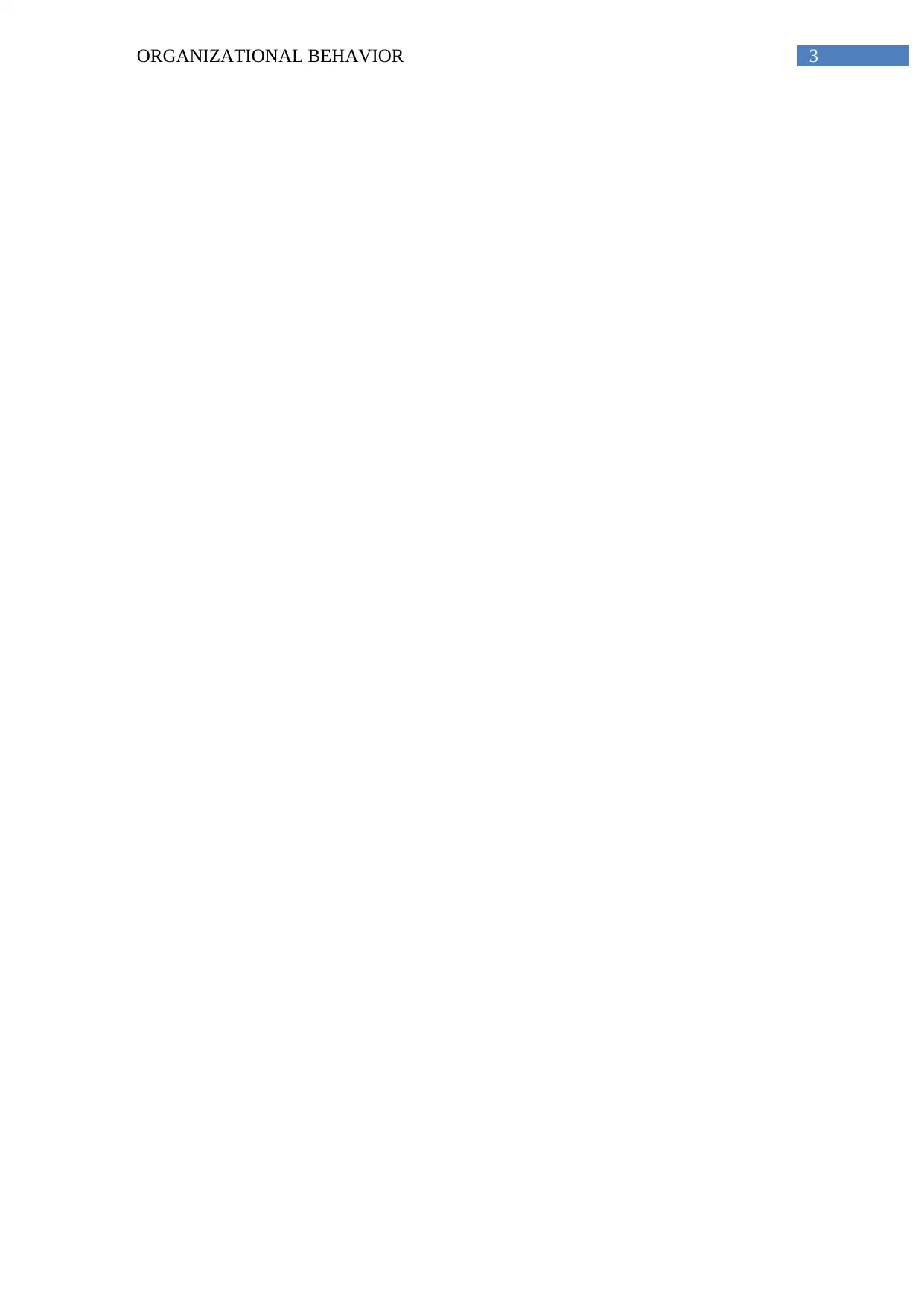
3ORGANIZATIONAL BEHAVIOR
Paraphrase This Document
Need a fresh take? Get an instant paraphrase of this document with our AI Paraphraser
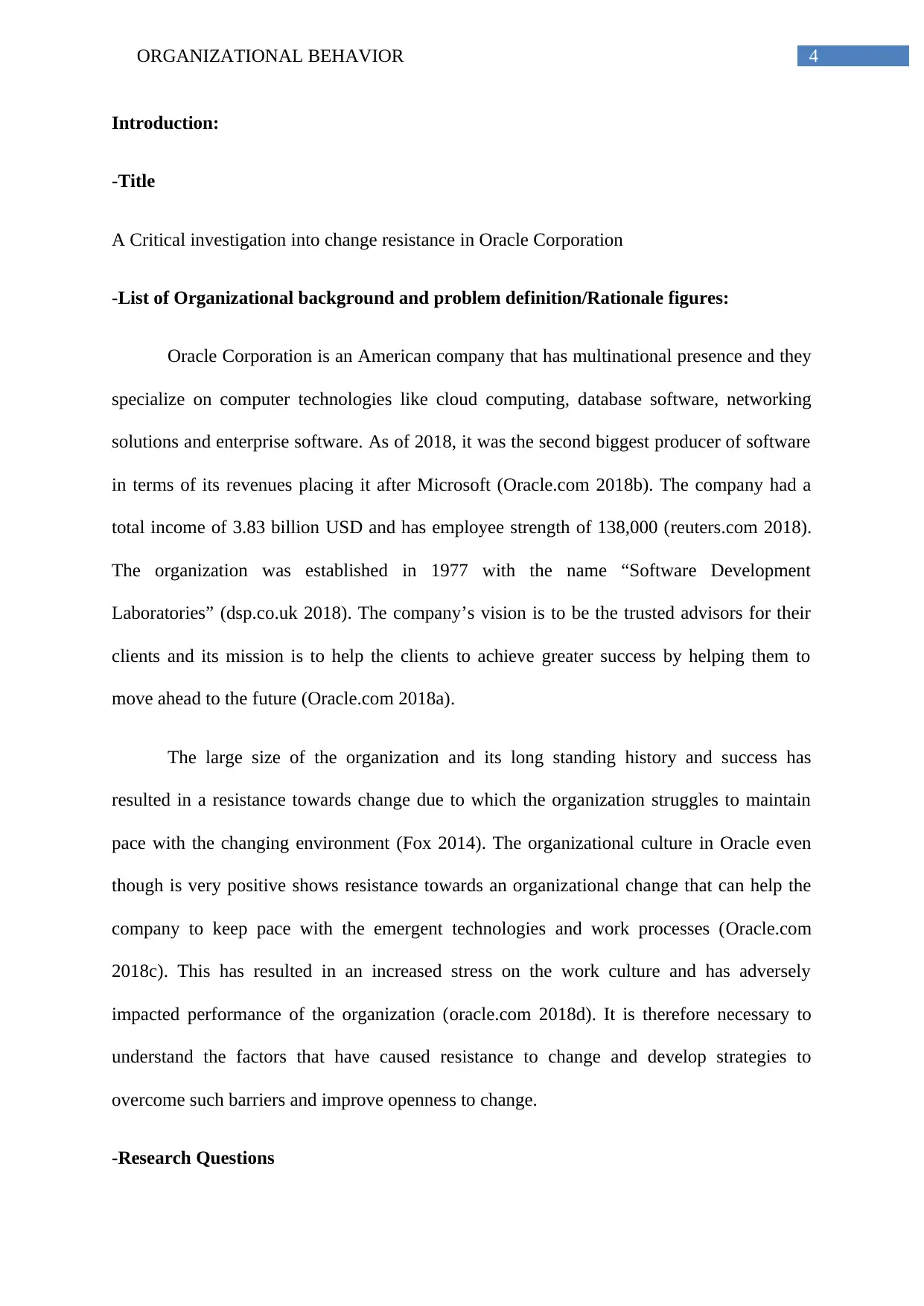
4ORGANIZATIONAL BEHAVIOR
Introduction:
-Title
A Critical investigation into change resistance in Oracle Corporation
-List of Organizational background and problem definition/Rationale figures:
Oracle Corporation is an American company that has multinational presence and they
specialize on computer technologies like cloud computing, database software, networking
solutions and enterprise software. As of 2018, it was the second biggest producer of software
in terms of its revenues placing it after Microsoft (Oracle.com 2018b). The company had a
total income of 3.83 billion USD and has employee strength of 138,000 (reuters.com 2018).
The organization was established in 1977 with the name “Software Development
Laboratories” (dsp.co.uk 2018). The company’s vision is to be the trusted advisors for their
clients and its mission is to help the clients to achieve greater success by helping them to
move ahead to the future (Oracle.com 2018a).
The large size of the organization and its long standing history and success has
resulted in a resistance towards change due to which the organization struggles to maintain
pace with the changing environment (Fox 2014). The organizational culture in Oracle even
though is very positive shows resistance towards an organizational change that can help the
company to keep pace with the emergent technologies and work processes (Oracle.com
2018c). This has resulted in an increased stress on the work culture and has adversely
impacted performance of the organization (oracle.com 2018d). It is therefore necessary to
understand the factors that have caused resistance to change and develop strategies to
overcome such barriers and improve openness to change.
-Research Questions
Introduction:
-Title
A Critical investigation into change resistance in Oracle Corporation
-List of Organizational background and problem definition/Rationale figures:
Oracle Corporation is an American company that has multinational presence and they
specialize on computer technologies like cloud computing, database software, networking
solutions and enterprise software. As of 2018, it was the second biggest producer of software
in terms of its revenues placing it after Microsoft (Oracle.com 2018b). The company had a
total income of 3.83 billion USD and has employee strength of 138,000 (reuters.com 2018).
The organization was established in 1977 with the name “Software Development
Laboratories” (dsp.co.uk 2018). The company’s vision is to be the trusted advisors for their
clients and its mission is to help the clients to achieve greater success by helping them to
move ahead to the future (Oracle.com 2018a).
The large size of the organization and its long standing history and success has
resulted in a resistance towards change due to which the organization struggles to maintain
pace with the changing environment (Fox 2014). The organizational culture in Oracle even
though is very positive shows resistance towards an organizational change that can help the
company to keep pace with the emergent technologies and work processes (Oracle.com
2018c). This has resulted in an increased stress on the work culture and has adversely
impacted performance of the organization (oracle.com 2018d). It is therefore necessary to
understand the factors that have caused resistance to change and develop strategies to
overcome such barriers and improve openness to change.
-Research Questions
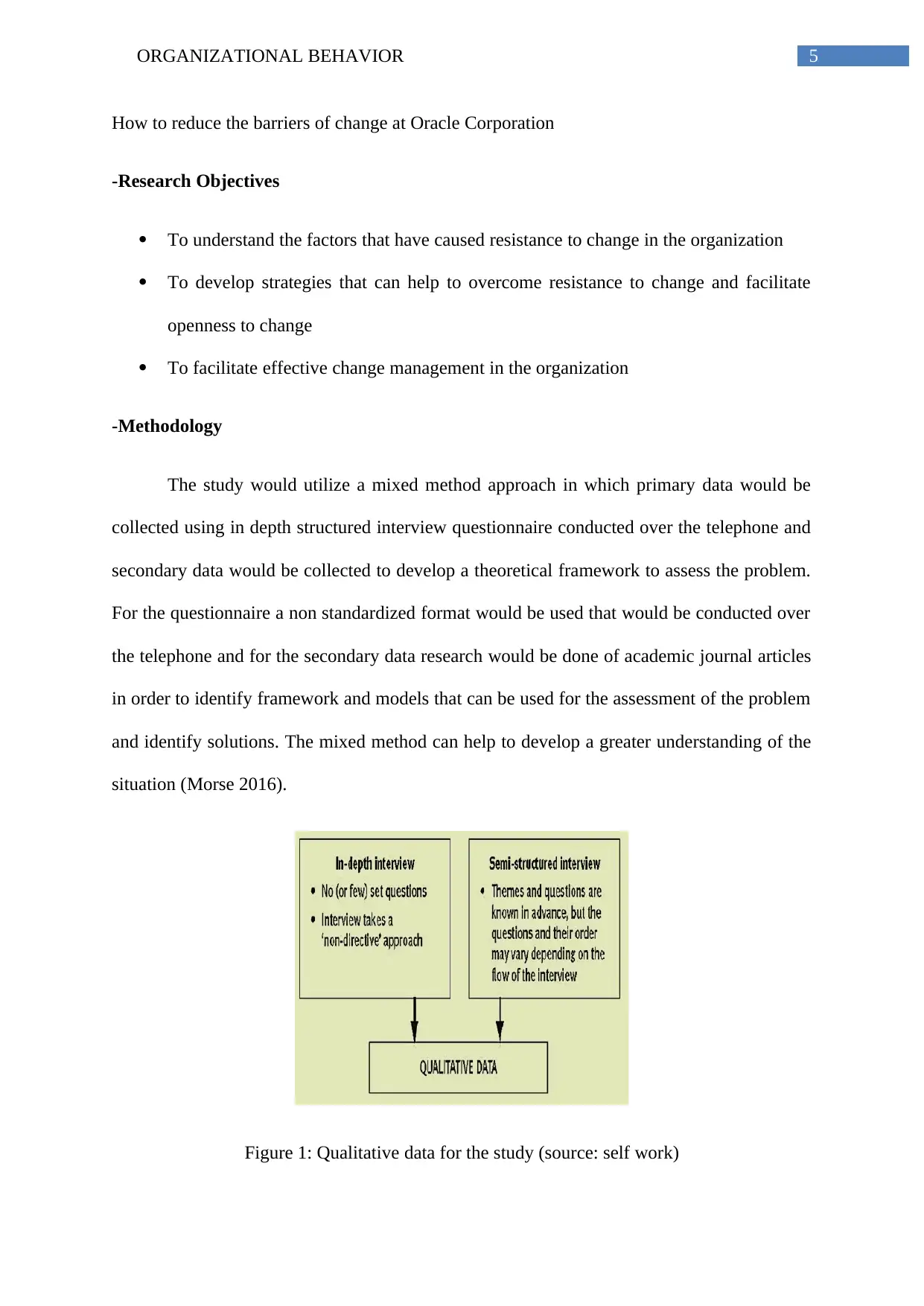
5ORGANIZATIONAL BEHAVIOR
How to reduce the barriers of change at Oracle Corporation
-Research Objectives
To understand the factors that have caused resistance to change in the organization
To develop strategies that can help to overcome resistance to change and facilitate
openness to change
To facilitate effective change management in the organization
-Methodology
The study would utilize a mixed method approach in which primary data would be
collected using in depth structured interview questionnaire conducted over the telephone and
secondary data would be collected to develop a theoretical framework to assess the problem.
For the questionnaire a non standardized format would be used that would be conducted over
the telephone and for the secondary data research would be done of academic journal articles
in order to identify framework and models that can be used for the assessment of the problem
and identify solutions. The mixed method can help to develop a greater understanding of the
situation (Morse 2016).
Figure 1: Qualitative data for the study (source: self work)
How to reduce the barriers of change at Oracle Corporation
-Research Objectives
To understand the factors that have caused resistance to change in the organization
To develop strategies that can help to overcome resistance to change and facilitate
openness to change
To facilitate effective change management in the organization
-Methodology
The study would utilize a mixed method approach in which primary data would be
collected using in depth structured interview questionnaire conducted over the telephone and
secondary data would be collected to develop a theoretical framework to assess the problem.
For the questionnaire a non standardized format would be used that would be conducted over
the telephone and for the secondary data research would be done of academic journal articles
in order to identify framework and models that can be used for the assessment of the problem
and identify solutions. The mixed method can help to develop a greater understanding of the
situation (Morse 2016).
Figure 1: Qualitative data for the study (source: self work)
⊘ This is a preview!⊘
Do you want full access?
Subscribe today to unlock all pages.

Trusted by 1+ million students worldwide
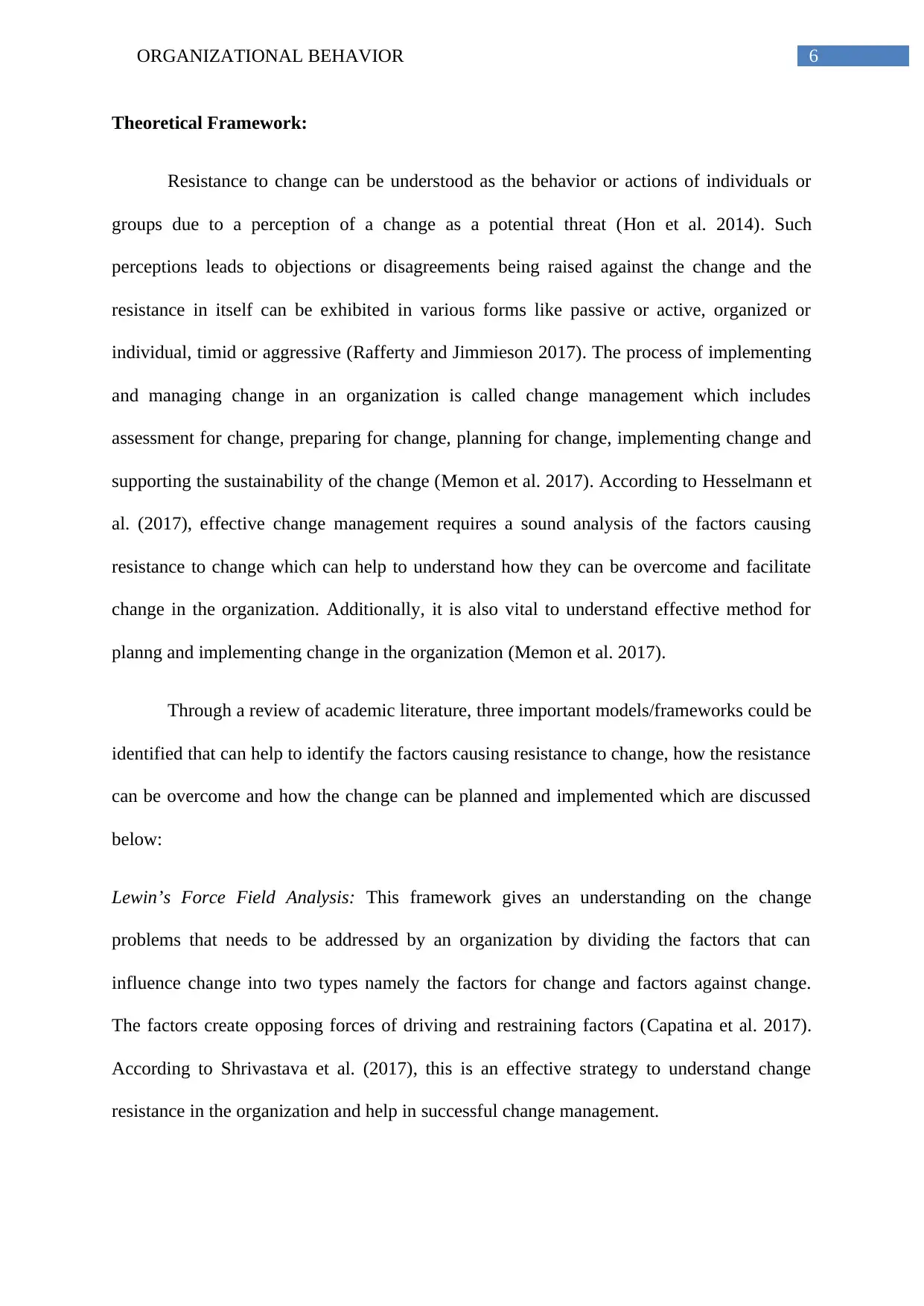
6ORGANIZATIONAL BEHAVIOR
Theoretical Framework:
Resistance to change can be understood as the behavior or actions of individuals or
groups due to a perception of a change as a potential threat (Hon et al. 2014). Such
perceptions leads to objections or disagreements being raised against the change and the
resistance in itself can be exhibited in various forms like passive or active, organized or
individual, timid or aggressive (Rafferty and Jimmieson 2017). The process of implementing
and managing change in an organization is called change management which includes
assessment for change, preparing for change, planning for change, implementing change and
supporting the sustainability of the change (Memon et al. 2017). According to Hesselmann et
al. (2017), effective change management requires a sound analysis of the factors causing
resistance to change which can help to understand how they can be overcome and facilitate
change in the organization. Additionally, it is also vital to understand effective method for
planng and implementing change in the organization (Memon et al. 2017).
Through a review of academic literature, three important models/frameworks could be
identified that can help to identify the factors causing resistance to change, how the resistance
can be overcome and how the change can be planned and implemented which are discussed
below:
Lewin’s Force Field Analysis: This framework gives an understanding on the change
problems that needs to be addressed by an organization by dividing the factors that can
influence change into two types namely the factors for change and factors against change.
The factors create opposing forces of driving and restraining factors (Capatina et al. 2017).
According to Shrivastava et al. (2017), this is an effective strategy to understand change
resistance in the organization and help in successful change management.
Theoretical Framework:
Resistance to change can be understood as the behavior or actions of individuals or
groups due to a perception of a change as a potential threat (Hon et al. 2014). Such
perceptions leads to objections or disagreements being raised against the change and the
resistance in itself can be exhibited in various forms like passive or active, organized or
individual, timid or aggressive (Rafferty and Jimmieson 2017). The process of implementing
and managing change in an organization is called change management which includes
assessment for change, preparing for change, planning for change, implementing change and
supporting the sustainability of the change (Memon et al. 2017). According to Hesselmann et
al. (2017), effective change management requires a sound analysis of the factors causing
resistance to change which can help to understand how they can be overcome and facilitate
change in the organization. Additionally, it is also vital to understand effective method for
planng and implementing change in the organization (Memon et al. 2017).
Through a review of academic literature, three important models/frameworks could be
identified that can help to identify the factors causing resistance to change, how the resistance
can be overcome and how the change can be planned and implemented which are discussed
below:
Lewin’s Force Field Analysis: This framework gives an understanding on the change
problems that needs to be addressed by an organization by dividing the factors that can
influence change into two types namely the factors for change and factors against change.
The factors create opposing forces of driving and restraining factors (Capatina et al. 2017).
According to Shrivastava et al. (2017), this is an effective strategy to understand change
resistance in the organization and help in successful change management.
Paraphrase This Document
Need a fresh take? Get an instant paraphrase of this document with our AI Paraphraser
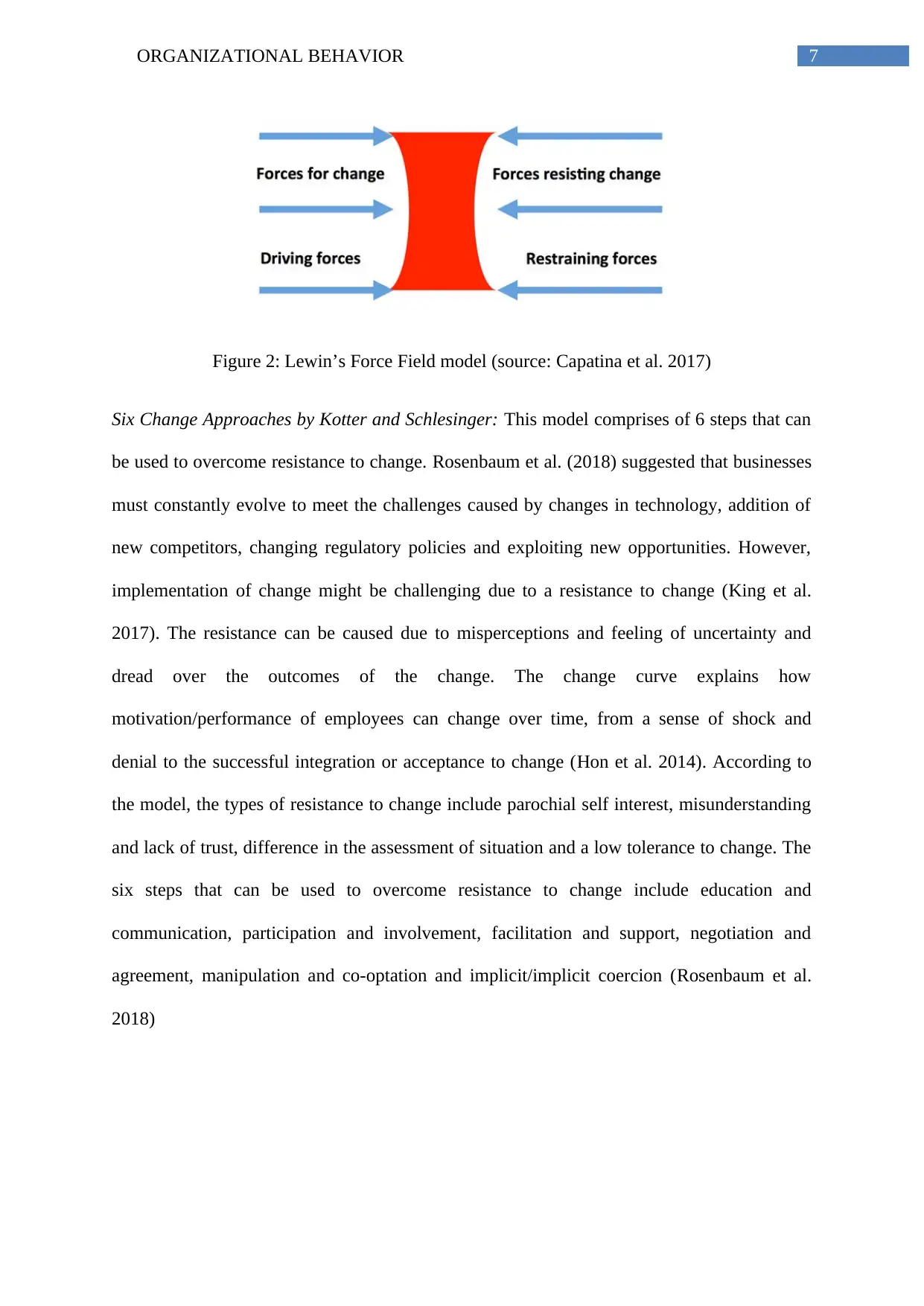
7ORGANIZATIONAL BEHAVIOR
Figure 2: Lewin’s Force Field model (source: Capatina et al. 2017)
Six Change Approaches by Kotter and Schlesinger: This model comprises of 6 steps that can
be used to overcome resistance to change. Rosenbaum et al. (2018) suggested that businesses
must constantly evolve to meet the challenges caused by changes in technology, addition of
new competitors, changing regulatory policies and exploiting new opportunities. However,
implementation of change might be challenging due to a resistance to change (King et al.
2017). The resistance can be caused due to misperceptions and feeling of uncertainty and
dread over the outcomes of the change. The change curve explains how
motivation/performance of employees can change over time, from a sense of shock and
denial to the successful integration or acceptance to change (Hon et al. 2014). According to
the model, the types of resistance to change include parochial self interest, misunderstanding
and lack of trust, difference in the assessment of situation and a low tolerance to change. The
six steps that can be used to overcome resistance to change include education and
communication, participation and involvement, facilitation and support, negotiation and
agreement, manipulation and co-optation and implicit/implicit coercion (Rosenbaum et al.
2018)
Figure 2: Lewin’s Force Field model (source: Capatina et al. 2017)
Six Change Approaches by Kotter and Schlesinger: This model comprises of 6 steps that can
be used to overcome resistance to change. Rosenbaum et al. (2018) suggested that businesses
must constantly evolve to meet the challenges caused by changes in technology, addition of
new competitors, changing regulatory policies and exploiting new opportunities. However,
implementation of change might be challenging due to a resistance to change (King et al.
2017). The resistance can be caused due to misperceptions and feeling of uncertainty and
dread over the outcomes of the change. The change curve explains how
motivation/performance of employees can change over time, from a sense of shock and
denial to the successful integration or acceptance to change (Hon et al. 2014). According to
the model, the types of resistance to change include parochial self interest, misunderstanding
and lack of trust, difference in the assessment of situation and a low tolerance to change. The
six steps that can be used to overcome resistance to change include education and
communication, participation and involvement, facilitation and support, negotiation and
agreement, manipulation and co-optation and implicit/implicit coercion (Rosenbaum et al.
2018)
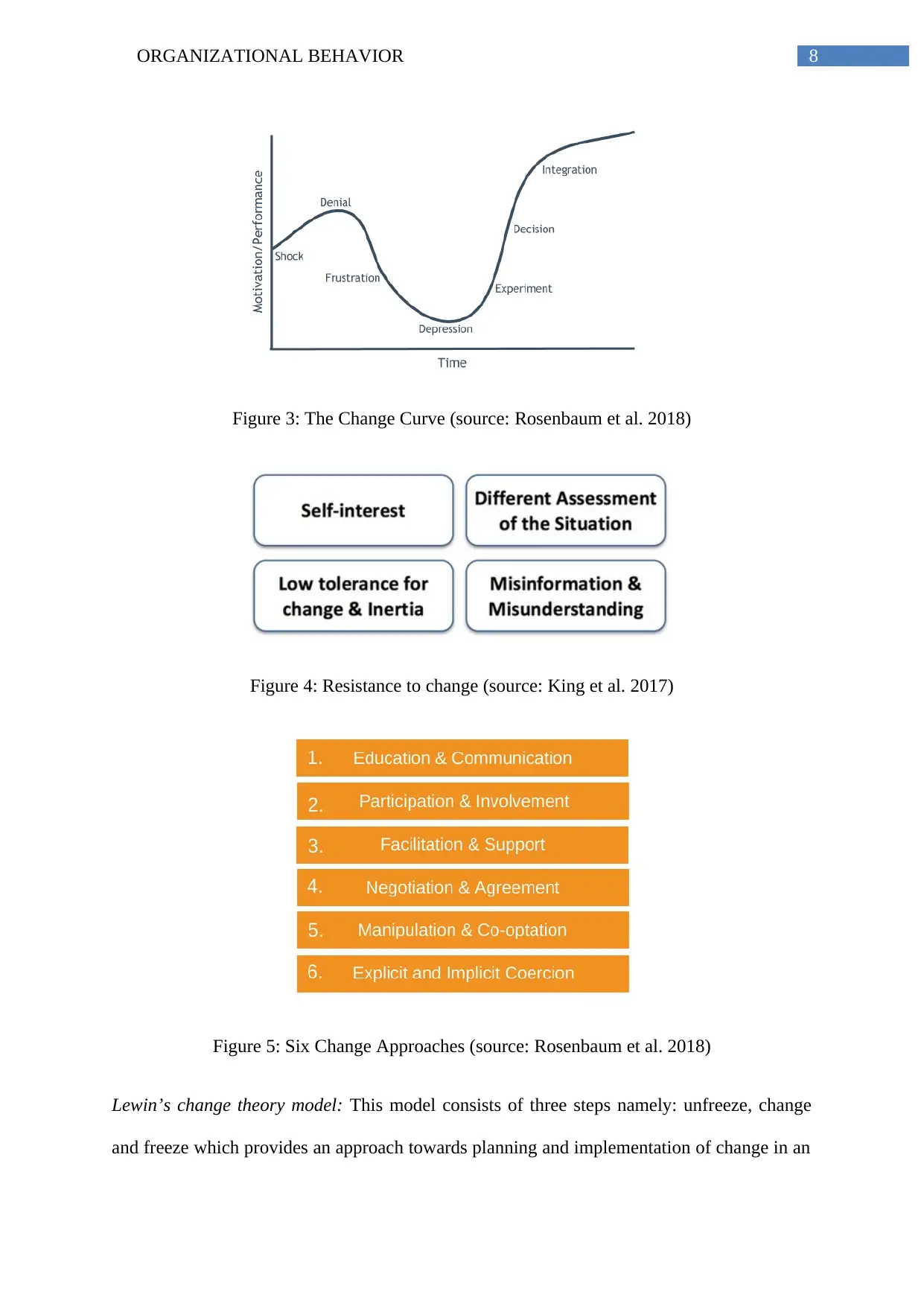
8ORGANIZATIONAL BEHAVIOR
Figure 3: The Change Curve (source: Rosenbaum et al. 2018)
Figure 4: Resistance to change (source: King et al. 2017)
Figure 5: Six Change Approaches (source: Rosenbaum et al. 2018)
Lewin’s change theory model: This model consists of three steps namely: unfreeze, change
and freeze which provides an approach towards planning and implementation of change in an
Figure 3: The Change Curve (source: Rosenbaum et al. 2018)
Figure 4: Resistance to change (source: King et al. 2017)
Figure 5: Six Change Approaches (source: Rosenbaum et al. 2018)
Lewin’s change theory model: This model consists of three steps namely: unfreeze, change
and freeze which provides an approach towards planning and implementation of change in an
⊘ This is a preview!⊘
Do you want full access?
Subscribe today to unlock all pages.

Trusted by 1+ million students worldwide
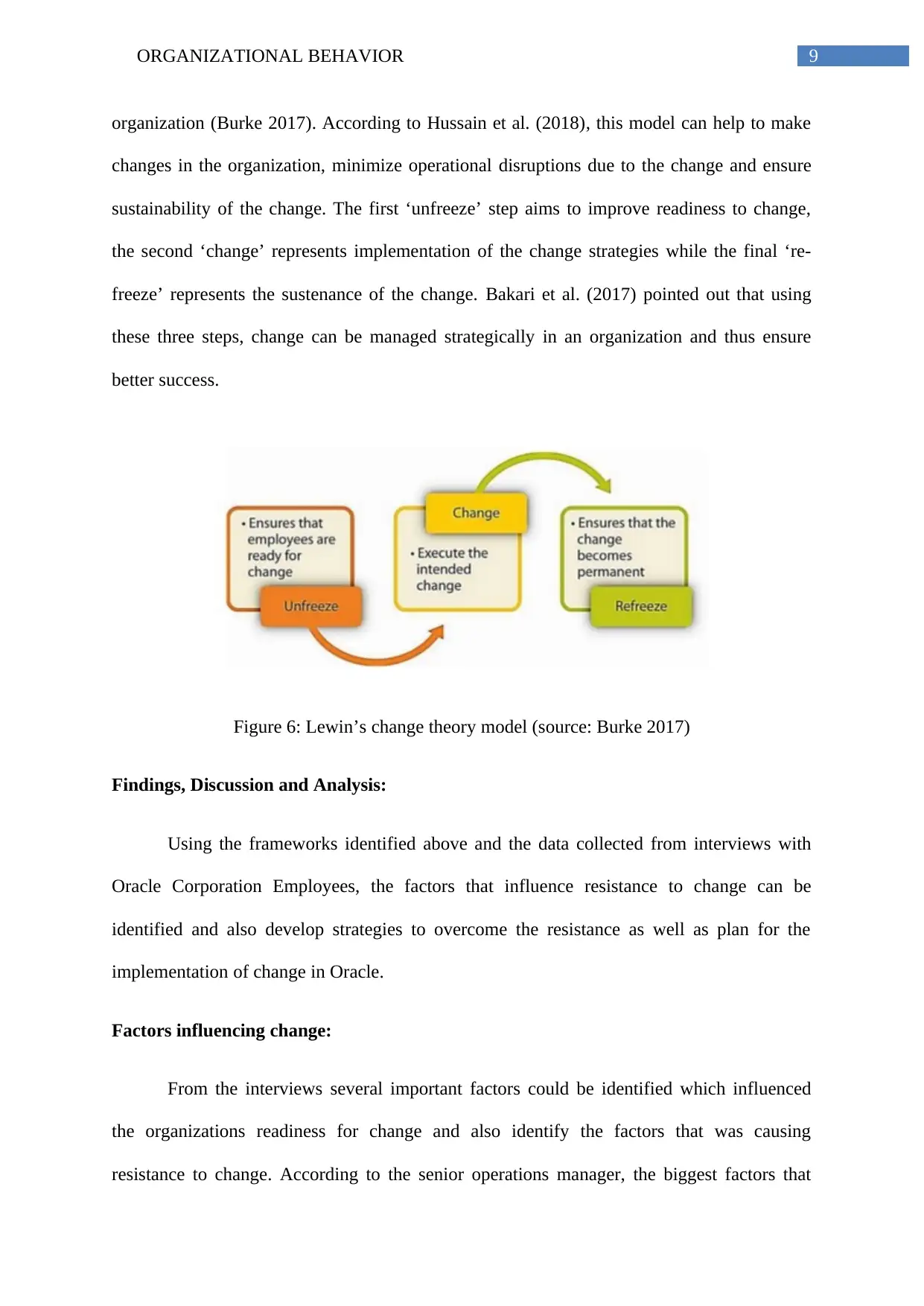
9ORGANIZATIONAL BEHAVIOR
organization (Burke 2017). According to Hussain et al. (2018), this model can help to make
changes in the organization, minimize operational disruptions due to the change and ensure
sustainability of the change. The first ‘unfreeze’ step aims to improve readiness to change,
the second ‘change’ represents implementation of the change strategies while the final ‘re-
freeze’ represents the sustenance of the change. Bakari et al. (2017) pointed out that using
these three steps, change can be managed strategically in an organization and thus ensure
better success.
Figure 6: Lewin’s change theory model (source: Burke 2017)
Findings, Discussion and Analysis:
Using the frameworks identified above and the data collected from interviews with
Oracle Corporation Employees, the factors that influence resistance to change can be
identified and also develop strategies to overcome the resistance as well as plan for the
implementation of change in Oracle.
Factors influencing change:
From the interviews several important factors could be identified which influenced
the organizations readiness for change and also identify the factors that was causing
resistance to change. According to the senior operations manager, the biggest factors that
organization (Burke 2017). According to Hussain et al. (2018), this model can help to make
changes in the organization, minimize operational disruptions due to the change and ensure
sustainability of the change. The first ‘unfreeze’ step aims to improve readiness to change,
the second ‘change’ represents implementation of the change strategies while the final ‘re-
freeze’ represents the sustenance of the change. Bakari et al. (2017) pointed out that using
these three steps, change can be managed strategically in an organization and thus ensure
better success.
Figure 6: Lewin’s change theory model (source: Burke 2017)
Findings, Discussion and Analysis:
Using the frameworks identified above and the data collected from interviews with
Oracle Corporation Employees, the factors that influence resistance to change can be
identified and also develop strategies to overcome the resistance as well as plan for the
implementation of change in Oracle.
Factors influencing change:
From the interviews several important factors could be identified which influenced
the organizations readiness for change and also identify the factors that was causing
resistance to change. According to the senior operations manager, the biggest factors that
Paraphrase This Document
Need a fresh take? Get an instant paraphrase of this document with our AI Paraphraser
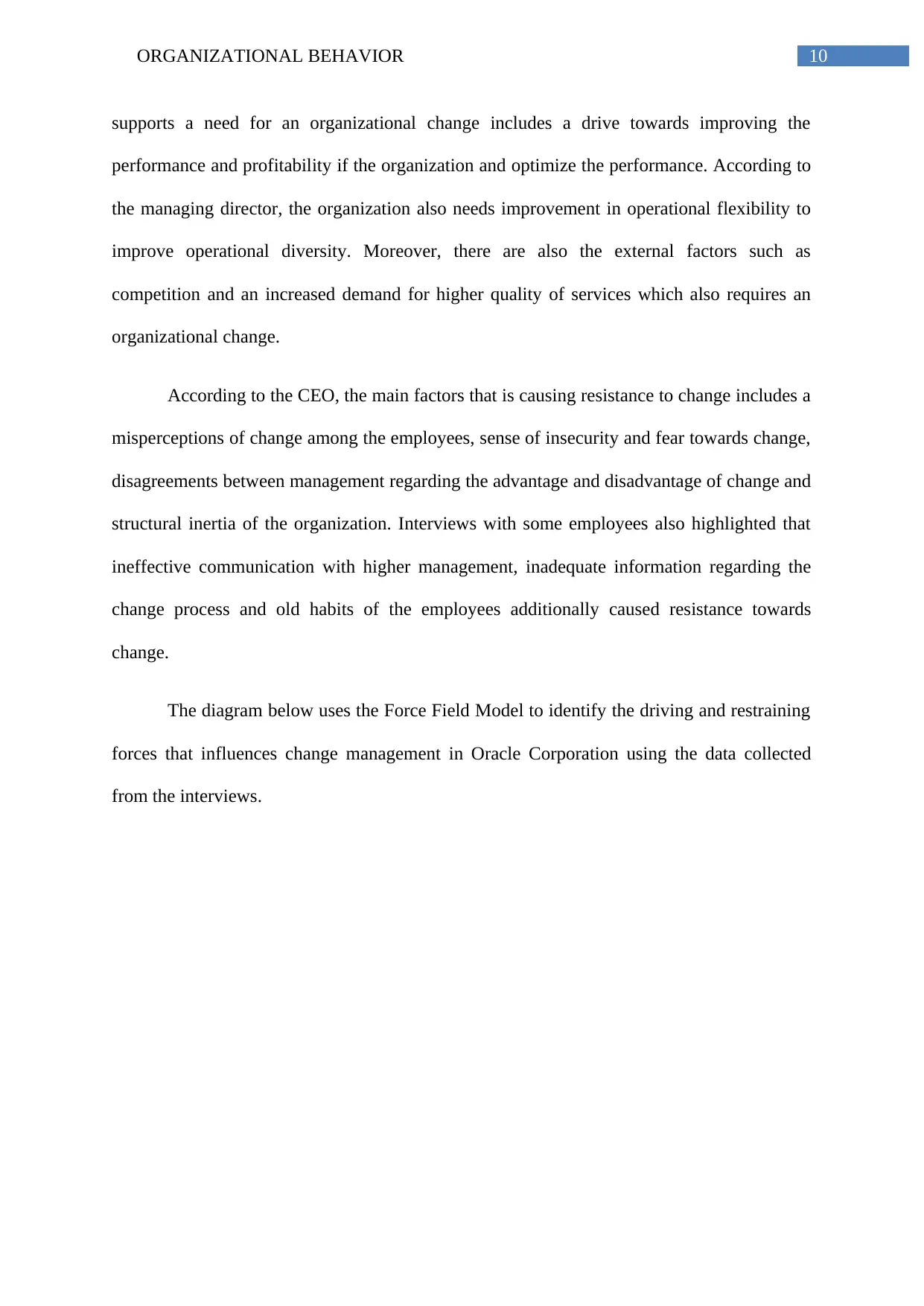
10ORGANIZATIONAL BEHAVIOR
supports a need for an organizational change includes a drive towards improving the
performance and profitability if the organization and optimize the performance. According to
the managing director, the organization also needs improvement in operational flexibility to
improve operational diversity. Moreover, there are also the external factors such as
competition and an increased demand for higher quality of services which also requires an
organizational change.
According to the CEO, the main factors that is causing resistance to change includes a
misperceptions of change among the employees, sense of insecurity and fear towards change,
disagreements between management regarding the advantage and disadvantage of change and
structural inertia of the organization. Interviews with some employees also highlighted that
ineffective communication with higher management, inadequate information regarding the
change process and old habits of the employees additionally caused resistance towards
change.
The diagram below uses the Force Field Model to identify the driving and restraining
forces that influences change management in Oracle Corporation using the data collected
from the interviews.
supports a need for an organizational change includes a drive towards improving the
performance and profitability if the organization and optimize the performance. According to
the managing director, the organization also needs improvement in operational flexibility to
improve operational diversity. Moreover, there are also the external factors such as
competition and an increased demand for higher quality of services which also requires an
organizational change.
According to the CEO, the main factors that is causing resistance to change includes a
misperceptions of change among the employees, sense of insecurity and fear towards change,
disagreements between management regarding the advantage and disadvantage of change and
structural inertia of the organization. Interviews with some employees also highlighted that
ineffective communication with higher management, inadequate information regarding the
change process and old habits of the employees additionally caused resistance towards
change.
The diagram below uses the Force Field Model to identify the driving and restraining
forces that influences change management in Oracle Corporation using the data collected
from the interviews.
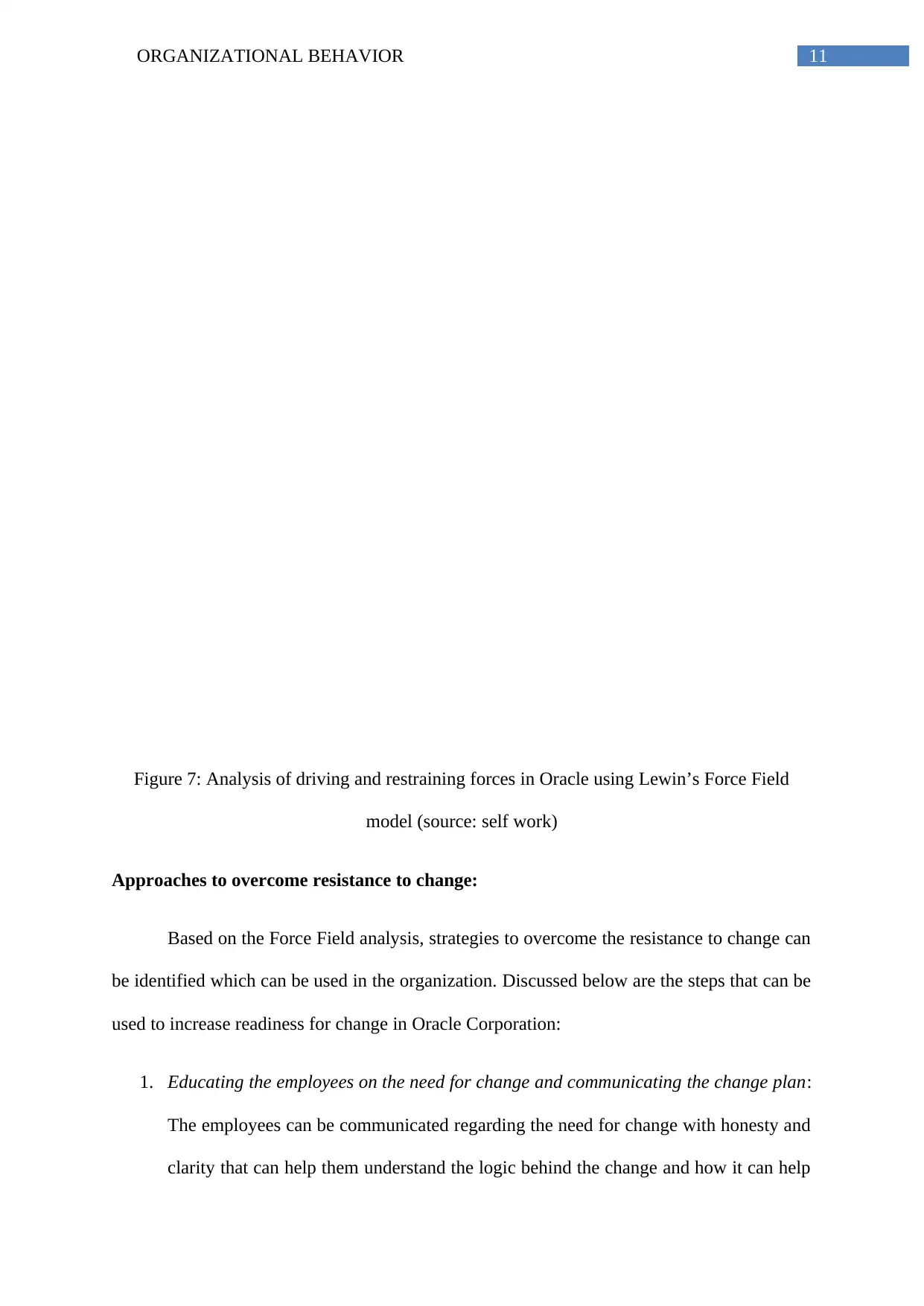
11ORGANIZATIONAL BEHAVIOR
Figure 7: Analysis of driving and restraining forces in Oracle using Lewin’s Force Field
model (source: self work)
Approaches to overcome resistance to change:
Based on the Force Field analysis, strategies to overcome the resistance to change can
be identified which can be used in the organization. Discussed below are the steps that can be
used to increase readiness for change in Oracle Corporation:
1. Educating the employees on the need for change and communicating the change plan:
The employees can be communicated regarding the need for change with honesty and
clarity that can help them understand the logic behind the change and how it can help
DrivingForces:1.Adrivetoincreaseprofitability2.Aneedtooptimiseperformance3.Needformoreoperationalflexibilioty4.IncreaseddeRestrainingForces:1.Ineffectivecommunication2.Misperceptionstochange3.Inadequateinformation4.Senseofinsecurity5.Disagreementsonadvantageand
Figure 7: Analysis of driving and restraining forces in Oracle using Lewin’s Force Field
model (source: self work)
Approaches to overcome resistance to change:
Based on the Force Field analysis, strategies to overcome the resistance to change can
be identified which can be used in the organization. Discussed below are the steps that can be
used to increase readiness for change in Oracle Corporation:
1. Educating the employees on the need for change and communicating the change plan:
The employees can be communicated regarding the need for change with honesty and
clarity that can help them understand the logic behind the change and how it can help
DrivingForces:1.Adrivetoincreaseprofitability2.Aneedtooptimiseperformance3.Needformoreoperationalflexibilioty4.IncreaseddeRestrainingForces:1.Ineffectivecommunication2.Misperceptionstochange3.Inadequateinformation4.Senseofinsecurity5.Disagreementsonadvantageand
⊘ This is a preview!⊘
Do you want full access?
Subscribe today to unlock all pages.

Trusted by 1+ million students worldwide
1 out of 23
Related Documents
Your All-in-One AI-Powered Toolkit for Academic Success.
+13062052269
info@desklib.com
Available 24*7 on WhatsApp / Email
![[object Object]](/_next/static/media/star-bottom.7253800d.svg)
Unlock your academic potential
Copyright © 2020–2025 A2Z Services. All Rights Reserved. Developed and managed by ZUCOL.




